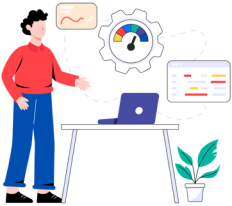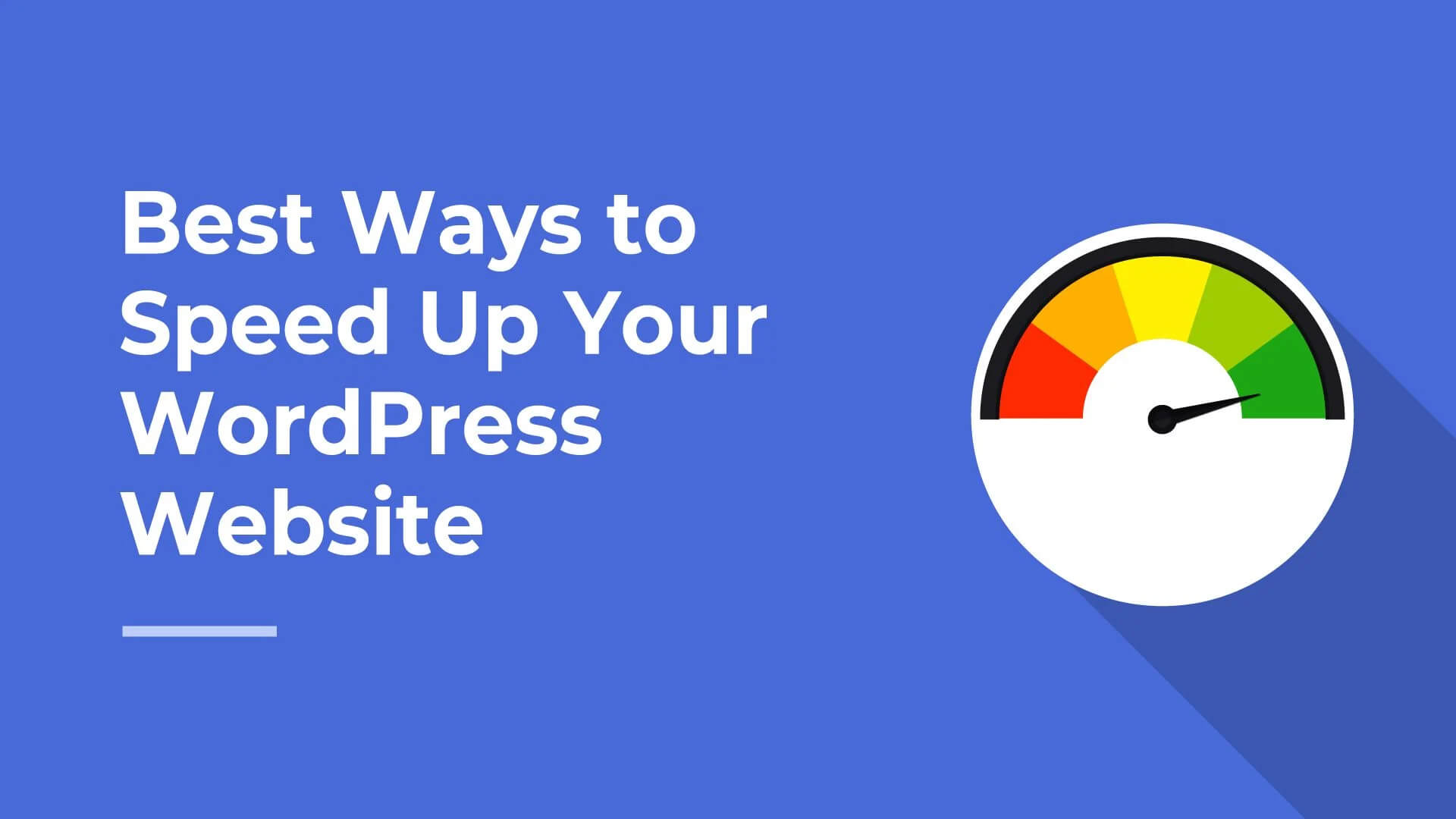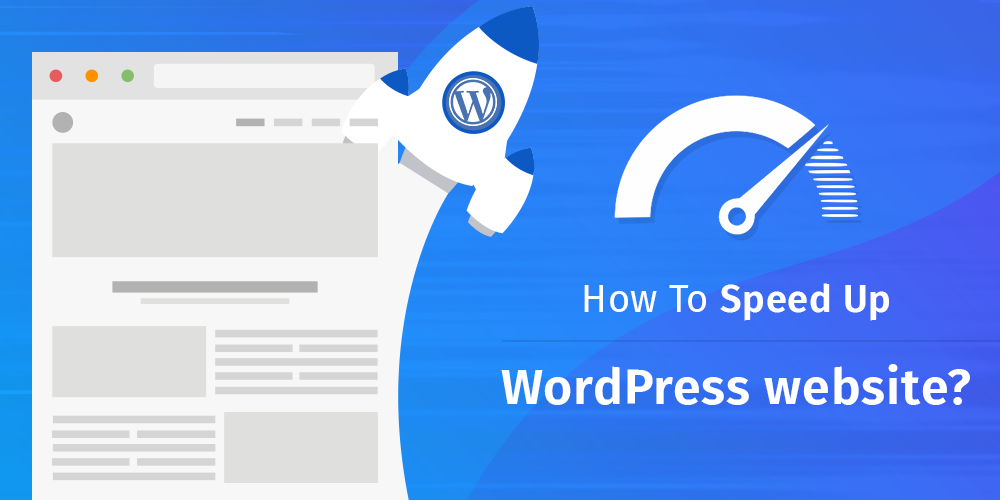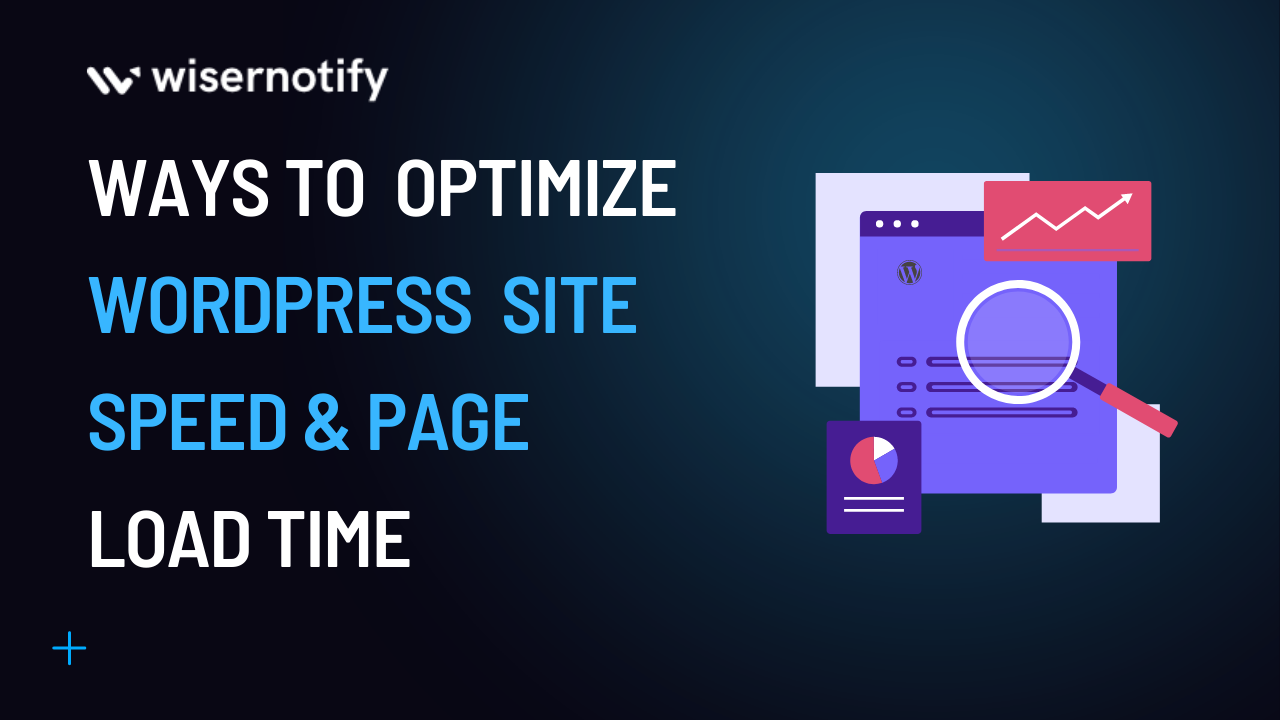Since the Internet was first conceived, website speed has been a significant concern. Users want to be able to navigate quickly and easily between web pages and don’t want to wait around for a page to load.
But now, with so many people using mobile devices, web hosts, and more companies relying on e-commerce sites, it’s more important than ever to optimize your WordPress site for speed.
In this blog post, we’ll look at some of the best ways to optimize your WordPress site’s speed so that it loads quickly and efficiently.
What is WordPress Speed Optimization?
WordPress is the most popular content management system (CMS) on the internet and powers over a quarter of all websites. Because of its widespread use, most people are familiar with WordPress and how it works.
WordPress is an excellent platform for creating websites, and it is also one of the best-managed WordPress hostings but can be slow at times. This can cause your website to load slowly or even crash. This article will discuss ways to optimize your website speed and page load time so your viewers have a better experience.
Start Free Trial
Highlight real-time activities like reviews, sales & sign-ups.
Why is WordPress Speed Optimization important?
- User experience: Slow loading times can lead to a poor user experience and may cause visitors to leave your website before seeing your content. This can lead to a high bounce rate and lower engagement.
- Search engine optimization: Search engines like Google consider page load speed as a ranking factor, meaning faster loading times can help your website rank higher in search results.
- Conversions: Faster website speed can also lead to higher conversion rates. Studies have shown that even a one-second delay in page load time can result in a 7% reduction in conversions.
- Mobile optimization: With more people using mobile devices to browse the internet, it’s essential to have a fast-loading mobile website. Slow loading times can lead to a poor user experience and lower mobile rankings and also it improves overall WordPress page speed.
- Scalability: A well-optimized website can handle high traffic loads without crashing, which is essential for businesses anticipating high traffic volumes during peak periods.
How Website Speed Affects User Experience
Website speed is one of the most important aspects of user experience. Google has stated that site speed is a ranking factor for them and they have released data to back up this claim.
The faster your website loads, the more likely you are to keep visitors on your site. If visitors wait for your page to load before they can use it, they will likely get frustrated and leave.
Many factors affect how fast your website loads, including:
- The size of your images and WordPress themes
- Your server’s bandwidth capacity
- The amount of JavaScript used on the page can affect WordPress site speed

Looking for a proven conversion optimization strategy?
Try WiserNotify to add social proof to your website.
- Trusted by 11,000+ online business
- Supports 200+ marketing & website builders
- Automate your social proof
How Website Speed Affects Search Engine Ranking
Website speed, or page load time, is a significant factor in how search engines rank your site. You must ensure your page loads quickly to rank well for competitive terms.
How fast your site loads depends on a few different factors: the size of the images on your page, the number of plugins and widgets you use on each page, the size of your CSS file (if it’s not optimized), and the number of external resources like third-party scripts and ads that are loaded on every page view.
If any of these factors is too slow for a user’s connection or device, it can cause a delay in loading time. That delay will harm how quickly your site loads—and that’s something search engines pay attention to when ranking your site.
Analysis of Your WordPress Website Speed
Best Tools for Test Website Speed
You can use many tools to measure your WordPress site speed and page load time, but the best ones will not only tell you how long it takes for visitors to load your site but also provide recommendations for how to improve it.
Pingdom is a tool that analyzes your website on a range of different factors and provides you with an overall grade and specific suggestions on how to improve each factor. It’s effortless to use—enter your website’s URL and click “check.” You’ll get an instant report on their analysis results, along with suggestions on how to improve them and boost WordPress speed.
The YSlow extension for Firefox is another good option if you’re looking for a free tool that offers detailed information about how well your site performs across several metrics and tips on how you can improve.
Interpreting Website Speed Test Results
If you’re looking for ways to optimize your WordPress website’s speed and page load time, you’ve come to the right place.
The first step in optimizing your site is to look at how fast it loads now. You can do this using a tool like Pingdom, which will tell you how long your site will load from different locations worldwide.
The second part of this process is interpreting the results of that test. For example, if your Pingdom report shows that 90% of visitors can load your site in less than 3 seconds, then you know this is already a good result.
But if it says that 50% or more of your visitors will have trouble loading your site in under 10 seconds, then this means that you need to improve speed!
Here are Some Common Topics that Impact the Website Speed
When it comes to optimizing your WordPress website and WordPress performance optimization, there are two things you need to remember:
-A slow site is bad for business. People expect a website to load in less than 3 seconds. If yours takes longer than that, you’re losing customers. So, it is important to improve your site speed.
-Remove unnecessary content from your website. It’s easier than you think to make your WordPress website faster. A lot of the time, all it takes is a little effort and the right tools.
Start Free Trial
Highlight real-time activities like reviews, sales & sign-ups.
Use these Easy Steps to Speed Up Your WordPress Website

Here are some steps or suggestions to speed up WordPress site speed. Read carefully and try to implement them on your website.
Select the Best Hosting Provider
Your website’s hosting is one of the most essential aspects of optimizing speed and page load time. It is the most optimized server configuration. If your website doesn’t load quickly, users will leave your site for one that does. They won’t wait around for your site to load when plenty of other options exist.
It’s not always easy to find a hosting company that offers everything you need at a price you can afford, but it is worth it to research before signing up with any company. Don’t just look at the cost; make sure that the company has all of the features you require regarding security, speed, and reliability.
Optimize All Images for the Web Server Resources
The first step to speeding up your WordPress website is to optimize all images for the web. This means that you need to ensure that each image has a large enough file size and isn’t unnecessarily large.
You also want to ensure you’re using the best quality image possible for your needs. The easiest way to do this is by using WordPress’s built-in image optimization tool (it’s called ‘Image Optimizer’). If you don’t use the plugin, you can use a free online tool like TinyPNG or JPEGmini.
Use Caching Plugins
The most important way to speed up your WordPress website is to use a WordPress caching plugin. WordPress Caching plugins cache your site’s pages and assets so that they don’t need to be loaded from the database whenever someone visits your site. This means that if you have an image on your site, for example, it will load much faster because the image will be stored in a server-side cache instead of having to pull it from your database every time someone views the page.
Enable Lazy Loading for Images and Videos
Lazy loading is a way of reducing the size of an image by only loading parts of it when needed. It’s not always necessary, but it can be very helpful in speeding up your website. First, go into WordPress’s settings page by clicking “Settings” in the header menu. Then, click “Media” in the left-hand column under “Site Settings.” You’ll see a box labeled “Lazy Loading.” Clicking on this will display a drop-down menu with options like “images,” “videos,” or both (if applicable).
Choose whichever option makes sense for your site’s needs—for example, if you have a lot of images on your site but not many videos, then leave this as “images” or vice versa! The WordPress media library is one of the best options to go for.
Minimizing HTTP requests
In WordPress, certain elements make up your website. These include PHP files, CSS files, and JavaScript files. When you want to load a particular page, these files need to be downloaded and loaded separately by the browser. This is why you might see multiple files downloaded when you open a new page on your website.
If you want to speed up your website, you must minimize the number of HTTP requests per page load time. To do this, try compressing all of your images into one file and embedding them into the HTML code of your webpage instead of using image tags. You should also use CSS sprites whenever possible to make fewer requests for images on each page load.
Minifying and Compressing Website Files
Minifying and compressing your website files can speed up your WordPress website. To do this, you’ll need two plugins: WP Optimize and Autoptimize.
First, you’ll need to install the WP-Optimize plugin. This plugin will help you optimize your site by removing unnecessary files and optimizing existing code, making it easier for your content to load quickly.
Then, install Autoptimize. This plugin will minify CSS and JavaScript files, making them smaller and more accessible to download. It will also combine CSS files into one file instead of having multiple separate files (which can sometimes load slowly).
Reducing Database Queries
The first step to optimizing your website speed is to reduce the number of WordPress database queries that WordPress makes. You can do this by using caching plugins or installing a caching plugin, like W3 Total Cache or WP Super Cache. These plugins will allow you to create static pages for your blog posts and other content, which will help speed up your site.
Start Free Trial
Highlight real-time activities like reviews, sales & sign-ups.
Best Practices for WordPress Speed Optimization

Here are the best practice points to improve your WordPress site speed and boost sales.
Update WordPress, Plugins, and Themes on a Regular Basis
Updating your WordPress lightweight theme, core and google analytics plugin can help keep your site secure and current with the latest features.
Use Content Delivery Network (CDN)
CDNs (content delivery networks) offer faster load times by distributing your site’s files across various servers worldwide.
Install an SEO-optimized WordPress Themes
Search engine-optimized themes will help improve your rankings by including meta tags and other code that search engines can read.
Delete Unused Plugins and Themes
Deleting unused plugins and themes can free up resources on your server, resulting in faster load times for visitors who browse your website. it will improve your WordPress site performance.
Using a Lightweight Page Builder
Lightweight page builders allow you to create pages quickly without having to write much code yourself, which can lead to faster load times compared with other editors like Visual Composer.
Use Gzip Compression
To get the most out of your site, it’s important to use Gzip compression. It will reduce the size of your pages and increase load times by as much as 70%.
Implement Browser Caching on Your WordPress Website Implement Server-Side Caching
By enabling browser caching, you can significantly reduce page load times by storing static files in a browser’s cache instead of reloading them each time a visitor visits your site.
Optimizing the Website’s Database
You can optimize your database by running regular queries that remove unnecessary data, such as old post revisions or spam comments; purging these items will reduce how much space they take up on your server and decrease its overall load time.
Apply these Advanced Techniques to Speed Up Your WordPress Website
Minimize the Use of External Resources
External resources commonly cause slow page speed and slow website performance. External resources include plugins, widgets, and other plugins, images, scripts, and style sheets. The more external resources you have, the slower your site will be.
To reduce the number of external resources used by your website, identify the ones causing problems and then remove them one by one until the problem disappears. Alternatively, you can use a plugin like WP Rocket to remove unused CSS/JS files from your site automatically.
Implement HTTP/2 Protocol on Your WordPress Websites
If you want to improve the loading speed of your WordPress website, then you need to implement the HTTP/2 protocol on it. It is a new version of the Hypertext Transfer Protocol that can significantly increase the speed of your website. It will also allow users to open multiple files simultaneously and reduce server load times by up to 70%. This means that it will be even easier for you to optimize your website for mobile devices.
Optimize Your Website Server Configuration
Your WordPress website is hosted on a web server, which means it’s stored in a remote location and accessed by users through the Internet.
The speed of your WordPress site depends on how fast your web hosting company can deliver your website to users. If your site is hosted on a slow server with poor configuration or if the server is overloaded with too many websites, then it will take longer for visitors to load your site.
You should optimize the server configuration to ensure your WordPress site loads as fast as possible. You can use tools like Pingdom Tools and GTMetrix to analyze your current configuration and find ways to improve it.
Implementing a reverse proxy
A reverse proxy is a web server between the user and your WordPress site. It is responsible for handling all of the requests made by the user, so it must be capable of handling hundreds or thousands of requests per second. This can be done using software like Nginx or Apache.
A reverse proxy server has several benefits:
- It allows you to run multiple websites from a single IP address (or multiple IP addresses).
- It can cache static files for faster retrieval by visitors.
- It improves security by allowing you to block access based on specific criteria such as IP address or URL pattern.
Configuring a Varnish cache
If a WordPress website gets a lot of traffic, it can be hard to serve up your pages fast enough. But with the help of a Varnish cache, you can boost your WordPress page load speed by as much as 300%!
Varnish is an HTTP accelerator that can be installed in front of any web server (including Nginx or Apache). When you visit a page on your site, rather than having your browser request each file individually from your web server, Varnish will send the entire page back to you packaged neatly into one package.
This means that only one request has to go through the entire stack of servers instead of each file being requested separately—which results in faster visitor load times.
Conclusion
WordPress is a popular and powerful CMS. It has many features that can make your website stand out from the crowd. However, it also comes with some limitations you must work around. One of these limitations is that WordPress websites can be notoriously slow.
In this post, we have discussed how you can optimize the speed of your WordPress site. Choose the right one according to your business needs.
FAQ’s
How Can I Improve My Slow WordPress Site?
There are several ways to improve the speed of a slow WordPress site, such as using a fast and reliable hosting service, optimizing images and other media, using a caching plugin, reducing the number of plugins and scripts used, and minifying CSS and JavaScript files.
How Can I Optimize My WordPress Site Speed Without Plugins?
To optimize the speed of a WordPress site without plugins, you can optimize images and other media by compressing them, using a content delivery network (CDN), enabling browser caching, reducing HTTP requests by combining files and using a lightweight and optimized theme.
Does Page Speed Really Affect SEO?
Page speed is essential in SEO as it directly impacts the user experience. Search engines like Google consider page speed a ranking factor and faster-loading pages tend to rank higher in search results than slower pages.
What Slows Down WordPress Sites?
Several factors can slow down WordPress sites, such as using a poor quality hosting service, using too many plugins or poorly coded plugins, using a poorly optimized theme, not optimizing images and other media, and using too many external scripts or widgets.
What Affects the Site Speed of WordPress?
Several factors can affect the site speed of WordPress, such as the hosting service used, the size and complexity of the website, the number of plugins and scripts used, the type and size of images and other media used, the optimization of CSS and JavaScript files, and the use of a caching plugin or a content delivery network.





